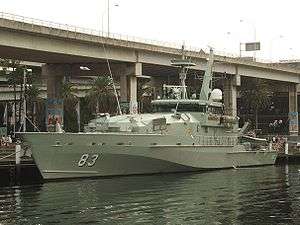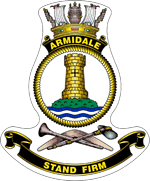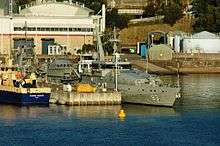HMAS Armidale (ACPB 83)
HMAS Armidale (ACPB 83), named for the city of Armidale, New South Wales, is the lead ship of the Armidale class of patrol boats serving in the Royal Australian Navy (RAN).
 HMAS Armidale at Darling Harbour in January 2008 | |
| History | |
|---|---|
| Namesake: | City of Armidale, New South Wales |
| Builder: | Austal, Henderson, Western Australia |
| Commissioned: | 24 June 2005 |
| Homeport: | HMAS Coonawarra, Darwin |
| Identification: |
|
| Motto: | "Stand Firm" |
| Honours and awards: | Three inherited battle honours |
| Status: | Active as of 2016 |
| Badge: |
 |
| General characteristics | |
| Class and type: | Armidale-class patrol boat |
| Displacement: | 300 tons standard load |
| Length: | 56.8 m (186 ft) |
| Beam: | 9.7 m (32 ft) |
| Draught: | 2.7 m (8.9 ft) |
| Propulsion: | 2 × MTU 4000 16V 6,225 horsepower (4,642 kW) diesels driving twin propellers |
| Speed: | 25 knots (46 km/h; 29 mph) |
| Range: | 3,000 nautical miles (5,600 km; 3,500 mi) at 12 knots (22 km/h; 14 mph) |
| Endurance: | 21 days standard, 42 days maximum |
| Boats & landing craft carried: | 2 × Zodiac 7.2 m (24 ft) RHIBs |
| Complement: | 21 standard, 29 maximum |
| Sensors and processing systems: | Bridgemaster E surface search/navigation radar |
| Electronic warfare & decoys: |
|
| Armament: |
|
Design and construction
The Armidale-class patrol boats are 56.8 metres (186 ft) long, with a beam of 9.7 metres (32 ft), a draught of 2.7 metres (8 ft 10 in), and a standard displacement of 270 tons.[1] The semi-displacement vee hull is fabricated from aluminium alloy, and each vessel is built to a combination of Det Norske Veritas standards for high-speed light craft and RAN requirements.[2] The Armidales can travel at a maximum speed of 25 knots (46 km/h; 29 mph), and are driven by two propeller shafts, each connected to an MTU 16V M70 diesel.[3] The ships have a range of 3,000 nautical miles (5,600 km; 3,500 mi) at 12 knots (22 km/h; 14 mph), allowing them to patrol the waters around the distant territories of Australia, and are designed for standard patrols of 21 days, with a maximum endurance of 42 days.[3][2]
The main armament of the Armidale class is a Rafael Typhoon stabilised 25-millimetre (0.98 in) gun mount fitted with an M242 Bushmaster autocannon.[3] Two 12.7-millimetre (0.50 in) machine guns are also carried.[4] Boarding operations are performed by two 7.2-metre (24 ft), waterjet propelled rigid-hulled inflatable boats (RHIBs).[2] Each RHIB is stored in a dedicated cradle and davit, and is capable of operating independently from the patrol boat as it carries its own communications, navigation, and safety equipment.[2][5]

Each patrol boat has a standard ship's company of 21 personnel, with a maximum of 29.[3][2] The Armidales do not have a permanently assigned ship's company; instead, they are assigned to divisions at a ratio of two vessels to three companies, which rotate through the vessels and allow the Armidales to spend more time at sea, without compromising sailors' rest time or training requirements.[2][6] A 20-berth auxiliary accommodation compartment was included in the design for the transportation of soldiers, illegal fishermen, or unauthorised arrivals; in the latter two cases, the compartment could be secured from the outside.[7] However, a malfunction in the sewerage treatment facilities aboard HMAS Maitland in August 2006 pumped hydrogen sulfide and carbon monoxide into the compartment, non-fatally poisoning four sailors working inside, after which use of the compartment for accommodation was banned across the class.[6][7]
Armidale was constructed by Austal in Henderson, Western Australia.[1] She was commissioned into the RAN at HMAS Coonawarra in Darwin on 24 June 2005.[1]
Operational history
Armidale is assigned to Attack Division, is based in Darwin, and performs border protection and fisheries protection patrols.
Citations
- Saunders (ed.), IHS Jane's Fighting Ships 2012–2013, p. 33
- Kerr, Plain sailing
- Wertheim (ed.), The Naval Institute Guide to Combat Fleets of the World, p. 22
- Heron & Powell, in Australian Maritime Issues 2006, p. 132
- Heron & Powell, in Australian Maritime Issues 2006, p. 131
- Kerr, Patrol boats shake down fuel faults
- McKenna, Gas risk remains for navy boats
References
- Books
- Heron, Wesley; Powell, Anthony (2007). "Welcome to the Armidale Class". In Forbes, Andrew; Lovi, Michelle (eds.). Australian Maritime Issues 2006 (PDF). Papers in Australian Maritime Affairs. Sea Power Centre – Australia. pp. 129–134. ISBN 0-642-29644-8. ISSN 1327-5658. Archived from the original (PDF) on 13 June 2011. Retrieved 12 May 2010.
- Saunders, Stephen, ed. (2012). IHS Jane's Fighting Ships 2012–2013. Jane's Fighting Ships. Coulsdon: IHS Jane's. ISBN 9780710630087. OCLC 793688752.
- Wertheim, Eric, ed. (2007). The Naval Institute Guide to Combat Fleets of the World: Their Ships, Aircraft, and Systems (15th ed.). Annapolis, MD: Naval Institute Press. ISBN 978-1-59114-955-2. OCLC 140283156.
- Journal and news articles
- Kerr, Julian (1 January 2008). "Plain sailing: Australia's Armidales prove fit for task". Jane's Navy International. Jane's Information Group.
- Kerr, Julian (8 December 2007). "Patrol boats shake down fuel faults". The Australian: Defence Special Report. News Corporation. p. 8.
- McKenna, Michael (2 January 2010). "Gas risk remains for navy boats". The Australian. Retrieved 7 January 2010.